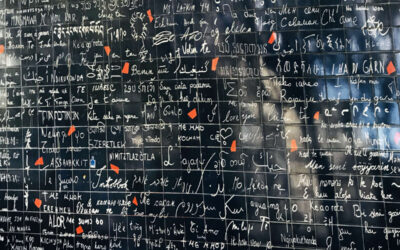Women have not always been recognized in the literary world. And that is not for a lack a talent. But with their own unique perspective, wit, and a strong sense of determination, there have been more than a few French female writers who have demanded attention and acclamation.
Some of their works are classics, others fictional, or even autobiographical. With works translated into English, here are some of the best French female writers that you will definitely want to read and discover. Allons-y!
1. George Sand (1804 – 1876)
One of the most popular writers in France in her lifetime is Amantine Lucile Aurore Dupin, better known as George Sand.
Choosing to wear male attire in public, she was a huge advocate for women’s rights and the working class. She even started her own newspaper, and her political writings brought her much attention. (She also openly had many famous lovers, including musician Frederic Chopin and actress Marie Dorval.)
Her most famous books include Indiana, and Ce que disent les fleurs (What the flowers say), and her Intimate Journal.
2. Colette (1873 – 1954)
Sidonie-Gabrielle Colette, who went just by the name Collette, was a famous writer, mime, actress and journalist who lived in Paris.
She married her 1st husband, writer Henry Gauthier-Villars in 1893 and her first series of books, called Claudine about the coming of age of a young woman, were published under his name. Her first novel, Claudine à l’École , was a satirical look at women’s education at the time in France, and the series would be much renowned.
Several years older than his wife, her husband encouraged her writing and introduced her to literary society and his rather libertine friends. However, when they divorced, Colette had no access to the sizeable earnings of the Claudine books as the copyright belonged to her husband.
Colette would go on to the stage with works that she wrote herself, to try to earn a living. Eventually, she took to writing plays that would become widely appreciated.
Her most famous work was Gigi, which tells the story of sixteen-year-old Gilberte (“Gigi”) Alvar. In 1951, Colette personally picked an unknown actress named Audrey Hepburn to play the title role in a stage production.
Other famous works of Colette include:
- Mitsou (1919)
- Chéri (1920)
- Le Blé en herbe (1923, meaning Ripening Seed)
- La Fin de Chéri (1926, meaning The Last of Chéri)
- La Naissance du jour (1928, meaning Break of Day)
She spent the WWII years as a journalist and editor, and living in the Palais Royal in Paris with her Jewish husband, under the threat of arrest. Although her writing was not political, after the war she was criticised for working with several media and newspapers in Paris, implicitly lending them her stature.
Colette was awarded the Académie Goncourt and made a Chevalier (1920) and Grand Officer (1953) of the Légion d’honneur in France.

3. Simone de Beauvoir (1908 – 1986)
French writer and female activist Simone de Beauvoir became famous for her writings on both feminist theory and feminist existentialism.
One is not born, but rather becomes, a woman.
Simone de Beauvoir
France would grant women the right to vote during her lifetime in 1946, due to the advocacy work of writers and philosophers like her.
Among her most famous books was the 1949 treatise The Second Sex, a detailed analysis of women’s oppression and contemporary feminism, as well as The Coming of Age. She would win France’s top prize for writers, the Prix Goncourt in 1954.
She would live with the famed French writer Jean-Paul Sartre for much of her life, but they did not have children. They had an open relationship, and Beauvoir was known to be bisexual. They are buried together in the Cemetery of Montparnasse in Paris.
4. Madame de la Fayette (1634 – 1693)
Born Marie-Madeleine Pioche de La Vergne, she became Madame de la Fayette in 1655 when she married François Motier, comte de La Fayette, a widowed nobleman 18 years her senior. (The famed Marquis de la Fayette of the American Revolution was born more than 100 years later.)
Marie’s sister-in-law, Louise de la Fayette, was a favorite of King Louis XIII, and the Lafayettes were active in the royal courts and literary society. Madame de la Fayette would begin her own salons in Paris, mixing with famous contemporaries of their time.
Madame de la Fayette began publishing works anonymously, including La Princesse de Clèves. The Princess of Cleves is considered among France’s first historical novels and one of the earliest novels in literature. Her other famous works include:
- La Princesse de Montpensier (1662)
- La Comtesse de Tende (1718)
- Histoire de madame Henriette d’Angleterre, première femme de Philippe de France, Duc d’Orléans (1720)
Some of her works including the “Mémoires de la cour de France pour les années 1688 et 1689” (Memories of the court of France in 1688-1689) were published posthumously in 1731.
She is buried in the Church of Saint-Sulpice in the 6th arrondissement of Paris.
5. Annie Ernaux (1940 – current)
Growing up in Normandy, Annie Ernaux initially trained as a teacher, working in the French education system.
She first published her book Les Armoires vides (Cleaned Out), an autobiographical novel in 1974 and since has gone from strength to strength.
Several of her books like “A Girl’s Story“, “A Man’s Place“, and “Simple Passion” were recognized on The New York Times Notable Books list. Other famous books and awards are:
- 1977 Prix d’Honneur for the novel Ce qu’ils disent ou rien
- 1984 Prix Renaudot for La Place
- 2008 Prix Marguerite-Duras for Les Années (the Years)
6. Marguerite Duras (1914 – 1996)
Marguerite Germaine Marie Donnadieu, known as Marguerite Duras, has been one of France’s top 20th century writers with much international acclaim.
A novelist, playwright, screenwriter, and filmmaker, her script for the film Hiroshima mon amour (1959) earned her an Oscar nomination.
She was born in French Indochina (now Vietnam), when France occupied the country, and many of her works reflected her dual upbringing.
Her most famous books include L’Amant (The Lover) for which she received the Prix Goncourt, and Les Yeux Verts (Green Eyes).
7. Germaine de Staël (1766 – 1817)
Germaine de Staël was the daughter of Jacques Necker, the French finance minister to King Louis XVI and Marie Antoinette. It would be her father’s dismissal from government for alerting the public as to the state of the government treasury, that would be one of the triggers of the 1789 French Revolution.
After her father died in 1804, Germaine took on the mantle and became a prominent figure in her own right and a leading French opponent of Napoleon Bonaparte.
She published a book called “Vie privée de Mr. Necker (Private life of M. Necker). Her other famous books include:
- De l’Allemagne (from Germany), 1813
- Sophie ou les sentiments secrets, 1786
- Jane Gray, 1787 (about the tragic English Queen)
- Delphine, 1802
- Corinne ou l’Italie, 1807
- La Sunamite.
The English poet Lord Byron proclaimed her Europe’s greatest living writer, but “with her pen behind her ears and her mouth full of ink”.

8. Ève Curie (1904 – 2007)
The younger daughter of Marie Curie, Eva Curie was one of the few in the family who would not work in the field of science. She was also one of the few in her family who didn’t win a Nobel prize. (Her parents, elder sister Irene and her husband, as well as Eve’s husband are all Nobel prize winners.)
Instead, Ève Curie became a pianist, writer, and a diplomat. During WWII, she was based in the U.S. as a journalist, advocating for the Free France movement.
Ève Curie would write a biography about her mother called Madame Curie, which became a worldwide best seller in 1938, and in turn a film released in the United States in 1943. It would only be released in France after the war in 1947.
Her other works include books titled Voyage parmi les guerriers (“Journey among warriors”) and the collection “They speak for a nation, letters from France“.
Her husband, Henry Richardson Labouisse, Jr., would accept the Nobel prize for peace on behalf of UNICEF in 1965. Eve Curie was awarded the Croix de Guerre and the Officière de la Légion d’honneur in France.

If you enjoyed that article, you may like to read about female French poets and artists. A bientôt!




